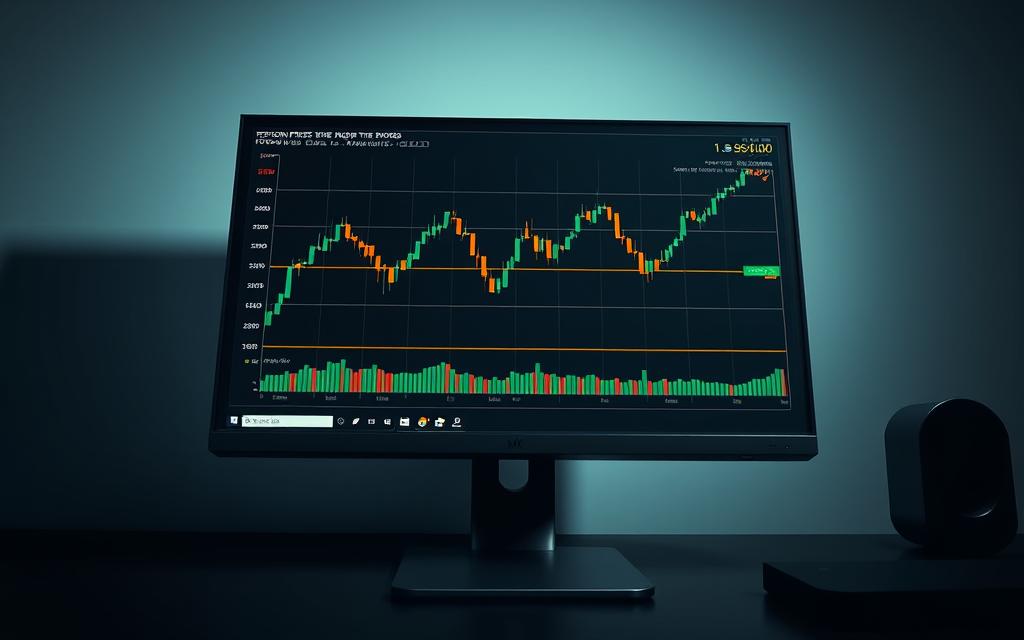Table of Contents
The cryptocurrency market has experienced significant volatility, with Bitcoin’s price retreating from its recent all-time highs near $112,000 to around $104,823.
This downturn has sparked intense interest in understanding the factors behind Bitcoin’s recent decline. As the market continues to fluctuate, experts are analyzing various technical indicators, macroeconomic factors, and market sentiment to explain the current price action.
Our analysis will delve into the key drivers of this decline, providing insights into the complex interplay of factors influencing Bitcoin’s price and the broader cryptocurrency landscape.
Current Bitcoin Market Snapshot
As June 2025 unfolds, Bitcoin’s price action has reached a critical juncture. The world’s largest cryptocurrency was trading at around $104,823 on Monday, June 2, 2025, after retreating from recent highs near $112,000.
Bitcoin’s Recent Price Action
Bitcoin’s price movement in June 2025 has been characterized by a retreat from the recent highs near $112,000 to the current trading levels around $104,823. This movement has significant implications for both retail and institutional investors. The current market dynamics present a mix of opportunities and risks, as technical patterns suggest potential volatility ahead.
The recent price action indicates that Bitcoin is currently navigating through a challenging phase. The cryptocurrency market is known for its volatility, and the current situation is no exception. Technical analysis suggests that the price is likely to experience significant fluctuations in the near future.
Key Support and Resistance Levels
Understanding the key support and resistance levels is crucial for traders. Currently, the critical support zone is between $103,000-$105,000, while the resistance area lies between $108,000-$112,000. The 200-day moving average at $97,600 serves as a major support level.
| Level Type | Price Range | Description |
|---|---|---|
| Support | $103,000-$105,000 | Critical support zone |
| Resistance | $108,000-$112,000 | Resistance area |
| Major Support | $97,600 | 200-day moving average |
The technical analysis indicates that the $100,000 threshold holds significant psychological importance in the current market conditions. Traders are closely monitoring these levels to make informed decisions.
The Bear Flag Pattern: Technical Analysis Explained
Technical analysis reveals that Bitcoin has formed a textbook bear flag pattern on its four-hour chart, indicating potential further decline. This pattern is a bearish continuation indicator that has sparked concerns among traders about the potential for a significant price drop.

What Is a Bear Flag Pattern?
A bear flag pattern is a technical analysis chart pattern that indicates the potential continuation of a downtrend. It forms after a sharp decline in price, followed by a consolidation period where the price moves within a parallel channel, typically with a slight upward bias. This pattern is considered bearish because it often precedes a further decline in price.
Current Technical Indicators
Currently, Bitcoin’s price action on the four-hour chart shows a clear bear flag formation. After bottoming at approximately $103,100 on May 31, Bitcoin consolidated in an upward parallel channel following the sharp decline from its $111,814 all-time high reached on May 22. The momentum indicators suggest a weakening upward pressure, which could lead to a breakout below the support level at $105,000.
Potential Price Targets Based on Technical Analysis
According to the bear flag pattern, if the support at $105,000 fails to hold, the projected price target is $97,709. This target is derived from the height of the preceding downtrend, which is then projected downward from the breakout point. Traders are closely watching the $105,000 level as a critical support that could determine the next significant move in Bitcoin’s price.
Elon Musk’s XChat Announcement: Impact on Bitcoin
In a move that has left many in the crypto community questioning the technical details, Elon Musk unveiled XChat, touting its “Bitcoin-style encryption” features. This announcement has sparked a mix of reactions, ranging from curiosity about the potential impact on Bitcoin’s price to skepticism regarding the technical claims made about XChat.
Details of the XChat “Bitcoin-Style Encryption” Claims
Elon Musk’s XChat is marketed as a secure messaging app with features that include “encryption, vanishing messages and the ability to send any kind of file. Also, audio/video calling,” as stated by Musk. However, cybersecurity experts have pointed out that the term “Bitcoin-style encryption” may be misleading. Bitcoin primarily uses digital signatures rather than encryption, as noted by Ian Miers, Assistant Professor of Computer Science at the University of Maryland.
The confusion surrounding Musk’s claims highlights the need for clarity in the crypto space regarding technical terms and their implications. The use of “Bitcoin-style encryption” could be seen as an attempt to leverage Bitcoin’s reputation for security, even if the technical underpinnings differ.
Market Reaction to Musk’s Announcement
Despite the hype surrounding XChat’s launch, Bitcoin’s price remained relatively stable near $105,000 following the announcement. This stability suggests that, at least in the short term, Musk’s influence on the cryptocurrency market may be waning compared to previous years when his tweets could trigger significant price movements.
- The market’s muted reaction could indicate a growing maturity in the cryptocurrency space, with investors becoming less reactive to individual announcements.
- Alternatively, it might reflect skepticism about the technical merits of XChat’s “Bitcoin-style encryption” claims.
- The overall impact on Bitcoin’s price and the broader crypto market remains to be seen, as the dust settles on Musk’s latest venture.
The evolving dynamics between tech influencers like Elon Musk and the cryptocurrency market will continue to be a point of interest. As the crypto community assesses the implications of XChat, the conversation around trust, security, and technical accuracy in cryptocurrency-related innovations is likely to intensify.
Expert Analysis: Why Is Bitcoin Falling?
Industry experts are offering their perspectives on why Bitcoin is falling, providing a comprehensive analysis of the current market situation. The recent decline in Bitcoin’s price has sparked a flurry of discussions among investors and analysts alike, with various factors being cited as potential causes.

CoinPanel CEO Aran Hawker’s Perspective
CoinPanel CEO Aran Hawker has provided a detailed analysis of the current market trends, focusing on the impact of Elon Musk’s XChat announcement on Bitcoin’s price action. According to Hawker, there is no direct link between Musk’s announcement and Bitcoin’s core technology or value proposition. Hawker’s analysis highlights three critical points for retail traders to consider: the limited impact on Bitcoin’s future, the technical distinctions between Bitcoin’s infrastructure and messaging applications, and the assessment that XChat poses no serious threat to Bitcoin’s adoption.
Hawker’s insights suggest that the mention of “Bitcoin-style encryption” in Musk’s announcement is vague and lacks technical detail, which may have contributed to the market’s initial reaction. However, a closer examination reveals that Bitcoin’s robust infrastructure and Layer 1 and Layer 2 solutions are distinct from the features of XChat.
Cybersecurity Experts Weigh In
Cybersecurity experts are also weighing in on the current market situation, evaluating both the technical claims behind recent announcements and their potential impact on market sentiment. These experts emphasize that the security and decentralization of Bitcoin are key factors that differentiate it from other digital assets.
The analysis from cybersecurity experts underscores the importance of understanding the fundamental factors driving Bitcoin’s price decline. By examining the technical aspects of recent announcements and their implications for market sentiment, experts can provide a more nuanced understanding of the current market trends.
In conclusion, the expert analysis suggests that the recent decline in Bitcoin’s price is influenced by a complex array of factors, including market sentiment, technical developments, and macroeconomic trends. As the market continues to evolve, it is essential for investors to stay informed and consider multiple perspectives when making investment decisions.
Macroeconomic Factors Driving Bitcoin’s Decline
The recent decline in Bitcoin’s price can be attributed to a complex interplay of macroeconomic factors affecting global risk sentiment. As investors navigate through a landscape of heightened uncertainty and fears, the cryptocurrency market has not been immune to the pressures of global economic trends.
US-China Trade Tensions
Rising US-China trade tensions have significantly impacted investor confidence, prompting a move away from risk assets, including cryptocurrencies like Bitcoin. This shift has created downward pressure on Bitcoin’s price as investors seek safer havens.
The ongoing trade negotiations between the US and China have been a major source of uncertainty in the market. As tensions escalate, investors become increasingly cautious, leading to a decline in Bitcoin’s price.
Federal Reserve Policy Implications
The Federal Reserve’s policy decisions and interest rate expectations play a crucial role in shaping investor sentiment. Changes in monetary policy can influence the attractiveness of risk assets, including Bitcoin.
Recent indications from the Federal Reserve regarding potential interest rate adjustments have contributed to market volatility. Investors are closely watching these developments, as they can significantly impact Bitcoin’s price movements.
Global Risk Sentiment Shift
A notable shift in global risk sentiment has occurred, with investors becoming more risk-averse in response to macroeconomic conditions. This shift has affected Bitcoin’s performance, both as a risk asset and a potential safe haven.
As global economic conditions continue to evolve, the cryptocurrency market is likely to remain sensitive to these changes. Understanding the interplay between macroeconomic factors and Bitcoin’s price is crucial for investors navigating this complex landscape.

| Macroeconomic Factor | Impact on Bitcoin | Current Trend |
|---|---|---|
| US-China Trade Tensions | Increased uncertainty and downward pressure on price | Escalating tensions |
| Federal Reserve Policy | Influence on investor sentiment and risk asset attractiveness | Monitoring interest rate decisions |
| Global Risk Sentiment | Shift towards risk aversion affecting Bitcoin’s price | Increasing risk aversion |
Bitcoin’s Correlation With Traditional Markets
The linkage between cryptocurrency and traditional financial markets has grown stronger, with central bank decisions and labor market data increasingly influencing crypto price movements. This shift marks a significant change from Bitcoin’s earlier days when it traded more independently of traditional asset classes.

Changing Relationship With Equity Markets
Historically, Bitcoin’s price movements were less correlated with traditional equity markets. However, recent data indicates a growing correlation, particularly during periods of market stress. This change is partly due to increased institutional participation in the cryptocurrency market, making it more sensitive to macroeconomic factors and traditional market forces.
As institutional investors enter the cryptocurrency space, Bitcoin’s price action is becoming more aligned with broader market trends. This shift is evident in the way Bitcoin reacts to macroeconomic announcements and monetary policy changes, similar to traditional assets.
Bitcoin as a Risk Asset vs. Safe Haven
The debate around Bitcoin’s role as either a risk asset or a safe haven continues. During periods of high volatility, Bitcoin has sometimes acted as a safe haven, attracting investors seeking refuge from market turmoil. However, its increasing correlation with traditional markets also suggests that it can behave like a risk asset, moving in tandem with equities during market downturns.
The classification of Bitcoin as a risk asset or safe haven is complex and depends on various market conditions. As the cryptocurrency market matures and becomes more integrated with traditional financial systems, understanding its correlation with other asset classes is crucial for investors.
In conclusion, Bitcoin’s evolving relationship with traditional markets underscores the need for a nuanced understanding of its role in the broader financial landscape. As correlation patterns continue to shift, investors must stay informed about the factors driving these changes to make informed decisions.
Institutional Behavior During the Downturn
The ongoing price correction in Bitcoin has led to a closer examination of institutional investment strategies. As the market navigates this downturn, understanding how institutional investors are behaving is crucial.
ETF Flows and Institutional Positioning
Exchange-Traded Funds (ETFs) have been a significant avenue for institutional investment in Bitcoin. Recent data shows that physical ETPs (Exchange-Traded Products) continue to attract strong inflows, with nearly $5 billion in April. This indicates sustained institutional interest despite price volatility.
Institutional investors view Bitcoin as a strategic asset, particularly in an environment characterized by monetary erosion and fiscal overreach. The continued investment in Bitcoin through ETFs suggests a calculated approach to positioning portfolios.
| Month | ETF Inflows ($ Billion) |
|---|---|
| March | 4.2 |
| April | 5.0 |
Corporate Treasury Strategies
Companies like MicroStrategy have been at the forefront of corporate treasury strategies involving Bitcoin. These firms are adjusting their cryptocurrency trading strategies and portfolio allocations in response to market corrections.
The decision to maintain or adjust Bitcoin holdings is influenced by various factors, including market sentiment and fiscal policies. As crypto becomes more integrated into corporate treasury management, understanding these dynamics is essential.

Institutional behavior during the downturn signals a long-term confidence in Bitcoin as an asset class. As the market continues to evolve, monitoring these trends will be crucial for understanding Bitcoin’s future.
Profit-Taking Dynamics After Recent Highs
As Bitcoin reached new all-time highs, the market witnessed significant profit-taking dynamics that warrant a closer look. The surge in Bitcoin’s price has led to a complex interplay of investor behaviors, market reactions, and technical indicators.
The Psychology Behind $100,000 Bitcoin
The $100,000 price level has emerged as a significant psychological threshold for Bitcoin investors. According to James Butterfill, CoinShares’ head of research, breaking this level from a technical analysis standpoint is a considerable achievement. “Bitcoin has pushed past the 200-, 50-, and 30-day moving averages and has significantly outperformed all other asset classes,” he notes. However, Adrian Fritz, head of research at 21 Shares, cautions that the $100,000 level “isn’t yet fully validated as firm support.” This ambivalence reflects the nuanced psychology surrounding major price milestones.

On-Chain Analysis of Selling Pressure
On-chain data provides valuable insights into the distribution of selling pressure during Bitcoin’s recent price decline. By analyzing the behavior of different cohorts of Bitcoin holders, we can identify patterns in profit-taking activities. The data suggests that certain groups have been more active in selling their holdings, potentially influencing market momentum and price support levels.
| Cohort | Selling Pressure | Market Impact |
|---|---|---|
| Short-term Holders | High | Increased selling pressure |
| Long-term Holders | Low | Stable market support |
| Institutional Investors | Moderate | Mixed market reaction |
The current selling pressure and its impact on Bitcoin’s price momentum are critical factors in determining the cryptocurrency’s short-term trajectory. Understanding whether this pressure represents short-term profit-taking or a more significant shift in market sentiment is essential for investors and analysts alike.
AI-Powered Bitcoin Price Predictions
The world of cryptocurrency is abuzz with predictions as artificial intelligence (AI) models forecast Bitcoin’s price movements. Despite the current bearish technical setup, AI models remain optimistic about Bitcoin’s prospects for the remainder of June 2025. This section will examine how AI is being used to predict Bitcoin’s price, comparing these forecasts with traditional technical and fundamental analysis.
ChatGPT and Grok Model Forecasts
ChatGPT’s analysis suggests a base-case prediction of $118,000 by June 30, highlighting Bitcoin’s resilience and the possibility of renewed bullish sentiment. The AI model estimates a 65% probability that Bitcoin will finish June above $110,000, though breaking $130,000 would require a major bullish catalyst. For more detailed Bitcoin price predictions, you can visit InvestingHaven for expert insights.
xAI’s Grok model offers a more conservative outlook, predicting Bitcoin will trade around $108,000 by month-end, assuming continued institutional inflows and favorable regulatory developments. These predictions are based on complex algorithms that analyze vast amounts of market data, providing a unique perspective on potential price movements.

Comparing AI Predictions With Traditional Analysis
When comparing AI-powered predictions with traditional analysis methods, it’s essential to consider the strengths and limitations of each approach. Traditional technical analysis relies on historical price patterns and indicators, while AI models can process vast amounts of data, including market sentiment and external factors.
| Prediction Method | June 30 Price Forecast | Key Factors |
|---|---|---|
| ChatGPT | $118,000 | Resilience, Bullish Sentiment |
| xAI’s Grok | $108,000 | Institutional Inflows, Regulatory Developments |
| Traditional Technical Analysis | Varies | Historical Price Patterns, Indicators |
By integrating AI-powered predictions with traditional analysis, investors can form a more comprehensive outlook on Bitcoin’s potential price trajectory. This hybrid approach can help mitigate the limitations of individual methods, providing a more robust forecast.
The $100,000 Level: New Support or Temporary Ceiling?
The $100,000 price level has become a significant milestone for Bitcoin, raising questions about its role as a new support or temporary ceiling. As the cryptocurrency continues to navigate its price trajectory, understanding the implications of this level is crucial for investors and analysts.

Historical Context of Major Price Levels
Historically, major price levels such as $10,000, $20,000, and $50,000 initially acted as resistance before eventually becoming support levels for Bitcoin. This pattern suggests that significant psychological thresholds can transition from being barriers to becoming floors for the cryptocurrency’s price. The $100,000 level, having been a long-standing resistance, is now being tested as a potential support level.
According to Dovile Silenskyte, director of digital assets research at WisdomTree, “$100,000 was always more of a psychological milestone than a technical barrier, and the market has decisively moved beyond it.” This perspective underscores the idea that the $100,000 mark may not be as significant a technical barrier as it was perceived to be.
Expert Opinions on $100,000 as Support
Experts in the field are divided on whether the $100,000 level will hold as a support level. Silenskyte’s analysis suggests that rather than acting as a ceiling, $100,000 is increasingly looking like a new support level. This view is supported by the observation that investor behavior has not triggered widespread profit-taking at this milestone.
Technical analysis of the $100,000 level involves examining trading volumes, order book data, and price action around this threshold. If the price holds above $100,000 with significant trading volume, it could reinforce its role as a support level. Conversely, a failure to maintain this level could see it revert to being a resistance level.
The behavior of Bitcoin around the $100,000 mark provides insights into market sentiment and potential future price movements. As the market continues to evolve, monitoring this level will be crucial for understanding whether it has transitioned into a robust support level or remains a temporary ceiling.
Trading Strategies During Bitcoin’s Volatility
Navigating Bitcoin’s volatile market requires a well-thought-out trading strategy. Given the current market dynamics, retail traders should focus on risk management rather than aggressive positioning. The formation of the bear flag pattern suggests waiting for clear directional signals before entering new positions, particularly around the critical $104,800 support level.

Risk Management Approaches
Effective risk management is crucial during periods of high volatility. Traders should consider several key strategies:
- Monitor key levels: Watch for breaks above $108,000 or below $103,000.
- Volume confirmation: Look for increased trading volume to confirm breakouts.
- Risk management: Use stop-losses and position sizing appropriate for volatility.
- Patience: Avoid FOMO trading during uncertain market conditions.
For more insights on cryptocurrency investment strategies, you can visit this resource for additional guidance.
Key Levels to Watch for Traders
Identifying critical levels is essential for traders navigating Bitcoin’s market fluctuations. The support zone between $103,000-$105,000 and resistance levels at $108,000 and $112,000 are particularly important to watch. Traders should be prepared to adjust their strategies based on breaks or holds at these levels, ensuring they are managing risk effectively.
By focusing on these key areas and maintaining a disciplined approach to trading, traders can better navigate the challenges of Bitcoin’s current market conditions.
Bitcoin’s Supply Dynamics Post-Halving
The April 2024 Bitcoin halving event has significantly altered the cryptocurrency’s supply dynamics, influencing its price movements. According to Silenskyte, the halving has “cut new coin issuance in half, tightening supply at a time when demand is rising.” This imbalance is driving upward price momentum.
Impact of the 2024 Halving Event
The 2024 halving event has had a profound impact on Bitcoin’s issuance rate. By reducing the rate at which new Bitcoins are introduced into the market, the halving has affected the supply-demand balance. As demand continues to rise, the reduced supply is likely to exert upward pressure on the price.
The reduction in new supply has significant implications for the market. With fewer new Bitcoins entering circulation, the potential for supply constraints increases, particularly during periods of heightened demand from both institutional investors and retail traders.
| Factor | Pre-Halving | Post-Halving |
|---|---|---|
| New Coin Issuance | High | Reduced by half |
| Supply-Demand Balance | Balanced | Tightened supply |
| Price Momentum | Variable | Upward pressure |
Miner Behavior and Market Influence
Miner behavior has also been influenced by the halving event. Changes in mining profitability and hash rate adjustments are critical factors that can impact market liquidity and price pressure. As miners adapt to the new supply dynamics, their selling patterns may influence the market, potentially affecting Bitcoin’s price.
“The most recent ‘bitcoin halving’ in April 2024 has ‘cut new coin issuance in half, tightening supply at a time when demand is rising.’ This imbalance is driving upward price momentum.” – Silenskyte
As the market continues to evolve, understanding the impact of the halving on supply dynamics will be crucial for investors and traders. The interplay between reduced supply and increasing demand will likely remain a key driver of Bitcoin’s price in the coming months.
Regulatory Concerns Affecting Bitcoin’s Price
Bitcoin’s price is being heavily impacted by the uncertainty surrounding regulatory policies. The cryptocurrency market is highly sensitive to changes in the regulatory landscape, and recent developments have contributed to the current market volatility.
Current Regulatory Landscape
The current regulatory environment for cryptocurrencies varies significantly across different jurisdictions. In the United States, Europe, and Asia, regulatory bodies are taking different approaches to oversee the crypto market. According to CoinShares’ Butterfill, one of the main short-term risks is a resurgence in inflation, which could prompt the US Federal Reserve to raise interest rates, affecting the risk appetite for crypto investments.
Recent developments in major markets have highlighted the need for clearer regulatory frameworks. The possibility of a sharp reversal in the currently favorable political stance toward digital assets in the US is a significant concern. As WisdomTree’s Silenskyte notes, “While the regulatory tide has been turning more constructive in key markets, the risk of abrupt, politically motivated action could create near-term volatility and erode institutional confidence.”
Potential Policy Changes and Their Impact
Potential policy changes can have a profound impact on Bitcoin’s price trajectory. Firms operating in the crypto space are preparing for various regulatory scenarios, from supportive frameworks that could boost institutional adoption to restrictive policies that might create headwinds for the market. The anticipation or unexpected announcement of major policy changes can lead to significant market volatility.
For instance, a more supportive regulatory framework could enhance institutional confidence and potentially drive Bitcoin’s price higher. Conversely, restrictive policies could lead to decreased investor confidence and a subsequent decline in price. As the regulatory landscape continues to evolve, understanding these dynamics is crucial for investors and firms involved in the crypto market.
For more insights on how institutional investors could impact Bitcoin’s value, visit this article on the potential of institutional investors to propel Bitcoin to new heights.
Long-Term Bitcoin Price Forecasts
Looking ahead, several prominent financial institutions have shared their outlook on Bitcoin’s potential long-term price. These forecasts provide valuable insights into the future trajectory of this leading cryptocurrency.
Institutional Price Targets
Several major financial institutions have released their predictions for Bitcoin’s future price. For instance, Standard Chartered’s Geoff Kendrick forecasts that Bitcoin will reach $120,000 by Q2 2025 and $200,000 by the end of 2025, with a long-term target of $500,000 by 2028. Similarly, VanEck’s Matthew Sigel predicts a peak around $180,000 in 2025 under a dual-cycle peak scenario. ARK Invest’s Cathie Wood has also made headlines with her long-term predictions, suggesting a base case of $1.2 million by 2030.
These forecasts are based on various factors, including adoption rates, institutional investment flows, and macroeconomic conditions. As Cathie Wood noted, “The future of Bitcoin is closely tied to its adoption and the overall growth of the cryptocurrency market.” The diversity in these predictions highlights the complexity of forecasting cryptocurrency prices.
- Standard Chartered predicts $200,000 by end of 2025 and $500,000 by 2028.
- VanEck forecasts a peak around $180,000 in 2025.
- ARK Invest’s base case is $1.2 million by 2030, with a bull case of $2.4 million.
Bull and Bear Case Scenarios
Analyzing both bull and bear case scenarios provides a comprehensive view of Bitcoin’s potential future. The bull case is supported by increasing institutional investment and growing adoption. On the other hand, the bear case considers factors such as regulatory hurdles and market volatility.
According to ARK Invest, the bull case scenario could see Bitcoin reaching $2.4 million by 2030, while the bear case might result in a price around $500,000. As
“The cryptocurrency market is known for its volatility, and investors should be prepared for a range of outcomes,”
said an expert.
| Forecast Source | End of 2025 Target | Long-Term Target |
|---|---|---|
| Standard Chartered (Geoff Kendrick) | $200,000 | $500,000 by 2028 |
| VanEck (Matthew Sigel) | Peak around $180,000 | No official 2030 target |
| ARK Invest (Cathie Wood) | Not specified | $1.2 million base case by 2030; $2.4 million bull case |
The range of forecasts underscores the uncertainty and potential in the cryptocurrency market. Investors and enthusiasts alike must consider multiple scenarios when evaluating Bitcoin’s future.
Bitcoin’s Historical Resilience Through Market Cycles
Bitcoin has demonstrated an impressive capacity to bounce back from major corrections throughout its history. This resilience is evident in its ability to recover from significant downturns in 2013, 2018, and 2022, emerging stronger and more mature each time.
Previous Major Corrections and Recoveries
Analyzing past market cycles reveals several key patterns. In 2013, Bitcoin experienced a significant correction, followed by a robust recovery that pushed its price to new highs. Similarly, in 2018 and 2022, Bitcoin faced major downturns but managed to recover, often surpassing previous peaks.
| Year | Correction Magnitude | Recovery Duration |
|---|---|---|
| 2013 | 60% | 6 months |
| 2018 | 80% | 12 months |
| 2022 | 70% | 9 months |
These historical corrections and recoveries highlight Bitcoin’s resilience and its ability to rally after significant market downturns.
Lessons for Current Market Conditions
The current market situation can be better understood by drawing lessons from these historical patterns. Factors such as accumulation by long-term holders, capitulation events, and shifts in market sentiment have preceded previous Bitcoin market recoveries.
“The cryptocurrency market has demonstrated remarkable resilience through previous crashes, emerging stronger and more mature each time.”
As the market continues to evolve, understanding these historical patterns can provide valuable insights into potential future trends. The increasing institutional participation and regulatory clarity are likely to impact the dynamics of market corrections and recoveries.
In conclusion, Bitcoin’s historical resilience through market cycles offers a promising outlook for its future performance. By analyzing past corrections and recoveries, investors can gain a better understanding of the factors that drive Bitcoin’s support and market rally.
Conclusion: What’s Next for Bitcoin?
Bitcoin’s current market dynamics are shaped by a complex interplay of technical, macroeconomic, and sentiment factors. As we synthesize the key insights from our analysis, it becomes clear that the recent decline in Bitcoin’s price is not attributed to a single cause but rather a combination of various influences.
The bear flag pattern observed in the technical analysis suggests a potential continuation of the downtrend, while macroeconomic pressures such as US-China trade tensions and Federal Reserve policy implications have also played a significant role in shaping market sentiment. Furthermore, the shift in global risk sentiment has contributed to the decline in Bitcoin’s price.
Despite the bearish signals, there are bullish fundamentals that suggest the current correction might be temporary. The analysis by experts, including CoinPanel CEO Aran Hawker and cybersecurity experts, provides valuable insights into the potential future movements of Bitcoin. It’s essential to weigh these factors against the backdrop of market trends and price action.
To gauge Bitcoin’s likely price direction, investors should monitor key indicators and events, including support and resistance levels, institutional flows, and regulatory developments. The outlook for Bitcoin remains uncertain, with both risks and opportunities present in the current cryptocurrency market.
In conclusion, while the current analysis presents a challenging outlook for Bitcoin, it’s crucial for investors to maintain a long-term perspective when navigating the inherent volatility of the cryptocurrency market. By doing so, investors can better position themselves to capitalize on potential opportunities as they arise.
FAQ
What is causing the recent decline in Bitcoin’s price?
The recent decline in Bitcoin’s price can be attributed to a combination of factors, including macroeconomic uncertainty, regulatory concerns, and a shift in global risk sentiment. Additionally, the bear flag pattern observed in the technical analysis has contributed to the downward pressure on the price.
How does Elon Musk’s XChat announcement affect Bitcoin’s price?
Elon Musk’s XChat announcement, which included claims of “Bitcoin-style encryption,” had a mixed impact on the market. While some investors were optimistic about the potential for increased adoption, others were skeptical about the claims, leading to a mixed market reaction.
What is the significance of the 0,000 level for Bitcoin?
The 0,000 level is a significant psychological barrier for Bitcoin, and its breach can have a substantial impact on the market. Some experts believe that it can become a new support level, while others see it as a temporary ceiling.
How do institutional investors behave during Bitcoin’s downturn?
Institutional investors have been observed to be cautious during Bitcoin’s downturn, with some ETF flows and corporate treasury strategies indicating a risk-off approach. However, some experts believe that this can also present a buying opportunity for long-term investors.
What are the potential price targets for Bitcoin based on technical analysis?
Technical analysis suggests that Bitcoin’s price may be headed towards key support levels, with some analysts predicting a potential drop to ,000 or lower. However, others believe that the current technical indicators are oversold, making it a potential buying opportunity.
How does Bitcoin’s supply dynamics post-halving affect its price?
The 2024 halving event has reduced the supply of new Bitcoins, which can lead to increased demand and, subsequently, a price increase. However, the impact of miner behavior and market influence can also affect the price dynamics.
What are the long-term Bitcoin price forecasts?
Long-term Bitcoin price forecasts vary widely, with some institutional price targets predicting a significant increase, while others foresee a more moderate growth. The bull and bear case scenarios also depend on various factors, including adoption rates, regulatory environments, and global economic conditions.









